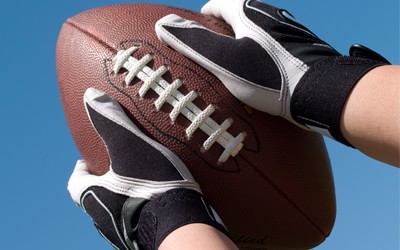Deflategate: Prof Franklin explains
 By now, most people in America have heard about "Deflategate," where the New England Patriots are alleged to have used underinflated footballs during the AFC championship game against the Indianapolis Colts.
By now, most people in America have heard about "Deflategate," where the New England Patriots are alleged to have used underinflated footballs during the AFC championship game against the Indianapolis Colts.
While some believe the Patriots footballs were tampered with, others have suggested that a change in temperature may have caused the Patriots' footballs to lose pressure. Carnegie Mellon Physics Professor Gregg Franklin explains how physics could have played a role in football's latest controversy.
"It's pretty simple physics," Franklin said. If you pump up a bicycle tire using air from a warm room and then take it outside on a cold winter day, you'll find that the pressure in the tire decreases as the air in the tire cools off. The air pressure in a football is no different.
"If a football is inflated to the minimum pressure allowed by the NFL—12.5 pounds per square inch—using warm air, the football's pressure will drop below this minimum value as the air cools."
Could this possibly be part of the answer to Deflategate?
Franklin said that, by rule, a decrease in temperature will correspond to a decrease in pressure. If the air temperature decreases by, for example, 10 percent, the pressure in an inflated object, such as a bicycle tire or football, will decrease by 10 percent.
This law can be used to calculate what would happen if the air pressure in a football was measured before a game in a nice warm room, perhaps at 72 degrees Farenheit or higher, and then measured again after the football cooled to an outdoor temperature in the mid-40s.
At first glance, this might sound like it would have a huge effect-about a 40 percent reduction in temperature—but Franklin said to be careful. Physics doesn't operate in Fahrenheit. To do the calculation correctly, Fahrenheit readings need to be converted to numbers that measure the temperature relative to absolute zero. When this conversion is done, the temperature of the football decreases by only about 5 percent.
So what does a 5 percent decrease in temperature do to a football initially inflated to 12.5 pounds per square inch (psi)? While it's tempting to say that the pressure drop will be 5 percent of 12.5 psi, this would be incorrect. The pressure measured by the pressure gauge, called "gauge pressure," is actually the pressure difference between the air inside the football and the air in the surrounding room.
To calculate the effect the drop in temperature has on the football, Franklin said to add the pressure of the air outside the football to the gauge pressure reading to find the true pressure. In this case, the outside air pressure would be around 14.5 psi, making the overall pressure on the football about 27 psi. As a result, the drop in pressure the football would experience is 5 percent of 27 psi, a decrease of 1.4 psi. The Patriot's footballs were reported to be underinflated by around 2 psi.
The bottom line?
"It's easy to see how the pressure in a football can drop from the NFL minimum of 12.5 psi to around 11 psi as it cools to an outdoor temperature simply because it will obey the laws of physics," Franklin said.
Depending on the initial temperature of the ball, a temperature drop could account for some, but not necessarily all, of the decrease in pressure exhibited by the Patriot's footballs. Franklin also notes that a change in ambient temperature is only one of a number of variables that could impact the pressure of any team's footballs.
"We also should remember that the laws of physics don't play favorites," Franklin said. "If the NFL measures the pressure of the balls when they are at room temperature, any team that provides footballs whose pressure falls in the range of 12.5 psi to 13.5 psi as required by the NFL, will end up playing with footballs whose pressure is well below 12.5 psi on cold winter days."
###
By: Jocelyn Duffy, jhduffy@andrew.cmu.edu, 412-268-9982